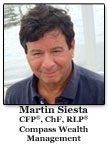Q: How did you get involved in financial Life Planning?
A: A number of years ago while I was working at the insurance company MetLife as a traditional financial planner, I had a great couple as clients. They had worked very hard their whole life for a secure retirement, which was now just 6 months away, and wanted my help doing some planning. That was in January and we agreed that we would meet again to do the actual planning in June when he actually retired. However, when I called in May to set up the appointment, I got their older daughter and she told me that her Mom had just passed away. She had been a lively person and there had been no indication of any health problems but she had been diagnosed with a very aggressive cancer. The experience just took the stomach out of me, and I thought, “My God, how terrible to work your whole life and put off everything until a retirement that might never occur. There has to be a way to balance the future and the present, to weave that together for a more satisfying life.”
Then I started noticing other client stories more acutely–the couples trying to afford the best schools or an array of material things to avoid the shame of not keeping up a successful appearance. I saw the strain it put on marriages. So I felt there were bigger stories than traditional planning could deal with.
Around 1999 or 2000 I read George’s The Seven Stages of Money Maturity and it really resonated. I took the 2-day workshop and then the 5-day advanced training. I started to see how my own life was out of balance. Going through the 3 Questions was profound for me and I just thought, “This makes complete sense” and my practice began to evolve around that.
Q: But you work for yourself now?
Yes, I left MetLife 4 or 5 years ago in order to build my own practice.
Q: So tell me about some clients where Life Planning made a difference.
Sure. I had a couple in their 40s, both teachers, and the guy was burnt out on teaching. He’d been doing it for a number of years and thought he wanted to do something different. She was also a teacher and, in addition, owned and ran a summer camp. She’s the niece of a very, very famous singer and an accomplished singer herself. She had occasionally toured with a singing group but her teaching and camp work left little time for that. So when I met with them what emerged was the idea of him taking a year off to really think about what he wanted to do next. He wanted more balance in his life, more time to be in nature and to spend time with his wife. The school schedule left him no time for that.
Her passion, her “torch”, was around doing more creative work with art and music. She had great passion for the camp, but her teaching work again left little time to do the things that she loved.
When we worked through the 3 Questions, one of her regrets was “I didn’t get to sing all the songs that needed to be sung…”. And we just sat there. There was a long, long pause and a lot of powerful emotion came up for her around that. She had this passion for touring and singing that she had set aside. Nothing remotely like this would have come out in a traditional financial planning engagement.
So, the work that we then needed to do for both of them was, “Well, what would that look like? And how could we get there?” In working together and looking at the money we were able to figure that he could definitely take a year off as a sabbatical. He was very environmentally oriented, so he spent a big part of that year backpacking in the canyon lands of Utah and Arizona. When he came back, he realized he was actually fine with teaching. It was just the workload in the particular school where he’d been that was too much. So, we worked on that and he got an offer from another school with smaller classes and courses more oriented toward the environment and science, and that has worked out much better.
She also made changes. Instead of teaching full time, she opted to work as a part-time substitute teacher and that gave her the flexibility she needed to sing on tour and organize things for the camp. All in all it’s worked out really wonderfully for both of them.
Q: What do you see that differentiates you as a Life Planner from other planners?
Well, one of the things I think we bring to this work is the willingness to look at both parts of life–the values and the assets–and to weave together the numbers to really see what’s possible. And then by really looking at what’s possible, to say, “Yes, you can” or “Yes, you can, but there’s this price” or “There are some priorities that you need to set so you can do that.” And there’s almost always a price. We have to pose the right questions, “Are you willing to have less of this in order to have more of that?” I think that’s really where we can do the magic. We work to see what’s possible. Then we look at the numbers and use our skills as financial planners to make the visions and the dreams happen. The result has been that we’ve doubled this practice over the last four years.
Q: What are some of the challenges you face?
For me, one of the biggest challenges was how do you make money doing this stuff? Most of my work is with middle income clients. It’s just kind of the way it happened and where I am most comfortable. As a result, I’ve needed to be very cognizant of the time it takes to do Exploration, Vision and Obstacles. I’ve developed a number of templates that save time; I put a lot on my website; I delegate what I can to my assistant; and I ask a lot of my clients. I really ask them to co-create the plan, to do a lot of the work in terms of organizing their financial data and thinking through obstacles. I also charge separately for the planning itself, in addition to earning fees for managing assets, and I vary the planning fee depending on the complexity of the client’s situation.
What I’ve found is that by really engaging clients in co-creating the plan, they are far more likely to follow that plan than if you paint yourself as the expert and create it for them.
It’s important to think of this as a business, to say, “This work is meaningful and important and for me to keep the doors open at the end of the year, I need to have a model that works financially.

